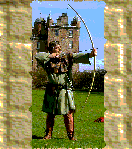top of page




Arrow Care
Wooden arrows usually require very little maintenance - however:

Nocks.
- Please make sure your arrow nocks fit your bowstring exactly. My horn reinforced nocks are cut to snap fit onto the kind of strings fitted to most medium weight longbows.
- If you have a particularly thick string you may need to file out the nocks. Carefully remove a little wood from each side using a fine file; if you have a fine round file you may be able to enlarge the base of the nock slightly to retain the 'snap fit'. Never force an arrow onto the string, this will eventually split the nock!
- If the nock is too loose, you can build up the serving on your string by whipping on a few turns of dental floss.
- To check if you have a correctly fitting nock - nock the arrow on the string as normal, as if you were about to shoot, turn the bow parallel to the ground and the arrow should hang on the string without falling off. A sharp downward tap on the string should release the arrow. Mind your feet when you do this with sharp arrows!
Shaft.
- After shooting, clean any mud from the shafts with a damp rag. This will also reveal any cracks in the wood or gouges made by other arrows striking yours. DO NOT SHOOT DAMAGED ARROWS which have been weakened in this way, they could disintegrate, maybe just as you are loosing.
- Sometimes wooden arrows need straightening and it is easy to do. Remember you will not achieve the straightness of modern aluminium or carbon arrows. You can use any source of gentle heat such as a gas ring, hair drier etc. Simply rotate the bent section of the shaft over the heat but don't let it get too hot. Then sight down the shaft and flex it to straighten it out. Hold it straight for a few seconds and it will stay as it cools.
Fletchings.
- 'Tired' fletchings can be 'magically' revived by quickly rotating them in the steam from a boiling kettle, but be careful when doing this as the steam could scald you.
- Remember when you store your arrows not to lean them on their fletchings as this distorts them.
Heads.
- I do not recommend shooting edged bodkins into conventional straw targets, particularly at short range as this can make pulling your arrows out very difficult; it is also quite damaging to the target. Under no circumstances twist such an arrow out from the target. If you blunt an edged bodkin a quick bit of attention with a fine file, following the profile of the point, will restore it. Modbods or edgeless bodkins are much kinder to straw targets
- If you are using rubber blunts, for instance in medieval re-enactment battles, before and after use check that the shaft is not pushing through the rubber blunt. This is caused by arrows striking shields and other hard objects on the battlefield. This is potentially dangerous and ARROWS IN THIS CONDITION SHOULD NOT BE USED. If the shaft is in good condition fit a new blunt.
- NEVER FIT A RUBBER BLUNT OVER A LIVE ARROW (ie one with a point on it). Fitting a blunt in this way is a lethal practice, do not do it.
bottom of page